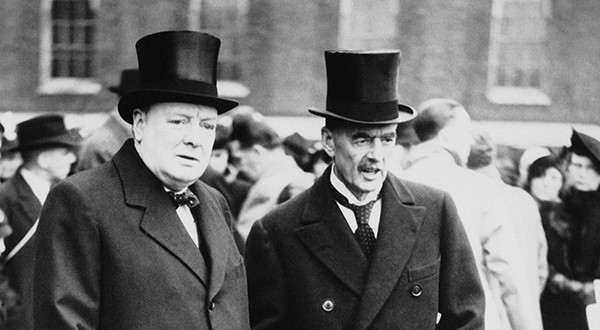
Yousuf Karsh, 1941 – Public Domain via Wikimedia Commons
The date is December 13, 1931. Winston Churchill, 57, is in New York City on a mission to recoup his losses from the 1929 stock market crash. Tomorrow, he’ll begin a lecture series on “the Pathway of English-Speaking Peoples” at the Brooklyn Academy of Music. But at about 10:30 p.m. tonight, he’ll be in a taxi on his way to his buddy Bernard M. Baruch’s mansion at 1055 Fifth Avenue near 87th Street. And his cab driver will get lost.
Advertisement
Churchill’s currently out of office. This period of the 1930s is described as the future prime minister’s ‘Wilderness Years’ by biographer Martin Gilbert. “In 1928, Winston Churchill was at the height of his career. Chancellor of the Exchequer and a powerful and popular orator, leadership of the Conservative Party seemed within his grasp. A year later, all had changed. The Conservatives were defeated and, when a National Government was formed in 1931, Churchill was not asked to join it. Though he was a lone figure at this point, his acute political sense, foresight and courage were undiminished.”

Winston Churchill visiting Charlie Chaplin in Hollywood in 1929. T. Garrett (+1935\), Public domain, via Wikimedia Commons
On the evening of Dec. 13, 1931, Churchill’s cab rides north on Fifth Avenue at a time when this part of Fifth Avenue was a two-way street. The taxi driver – who’s reportedly new to Manhattan – decides to turn the car around as Churchill gets confused about the building numbers. Churchill ultimately decides to exit the cab on the Central Park side of Fifth Avenue. He walks a few steps north and then looks to cross the street.
Advertisement
READ MORE: Seize the Day with Squadron A: The Upper East Side’s Historic Military Outfit
Churchill was a man who didn’t shy away from risk. “You must put your head into the lion’s mouth if the performance is to be a success,” he wrote in London to Ladysmith via Pretoria.
Back on Fifth Ave. in the concrete jungle, Churchill takes matters into his own hands to get to his friend’s house. But being from London, he’s used to traffic that keeps to the left. When he crosses the street, “Churchill looked to his right, saw no one coming and kept walking,” details The New York Times. “A car driven by an unemployed mechanic named Mario Contasino, moving about 30 miles an hour, dragged Churchill several yards and flung him into the street, bruising his right chest, spraining his right shoulder and cutting his forehead and nose.” The incident takes place between 76th and 77th streets.

Churchill and Neville Chamberlain, the chief proponent of appeasement (1935). Public domain via Wikimedia Commons
In the hospital, Churchill suffers from pleurisy, an inflammation above the lungs caused by infection. He’s in rough shape but decides to keep this a secret as he doesn’t want to alarm anyone. He also takes full responsibility for the accident with authorities, and even invites Contasino to visit him in the hospital.
READ MORE: A Twisted Tale of Twin Gynecologist Brothers Found Dead in Upper East Side Apartment
Over a month after the accident, Churchill gets prescribed unlimited alcohol by a doctor. “This is to certify that the post-accident convalescence of the Hon. Winston Churchill necessitates the use of alcoholic spirits, especially at mealtime,” read the prescription, dated January 26 1932. “The quantity is naturally indefinite, but the minimum requirement would be 250 cubic centimeters.” This converts to a quarter liter, or a bit over 8 ounces.
Churchill reschedules and delivers his speech at the Brooklyn Academy of Music on January 28, 1932.
Churchill played a crucial role in leading Great Britain to victory during World War II. Could things have turned out differently had he not survived this ordeal?





